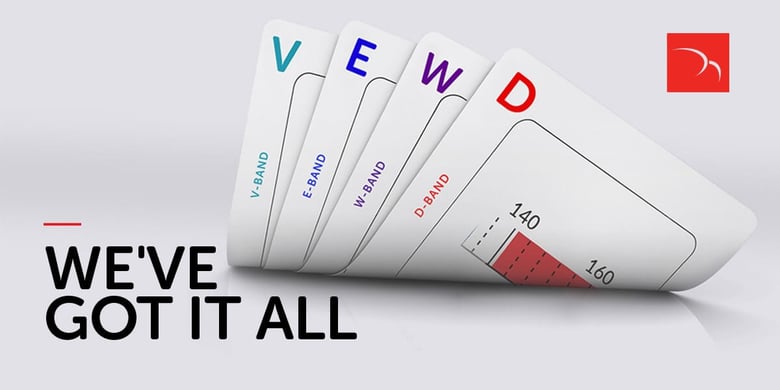[Updated June 2024]
In an earlier blog titled “Wireless Backhaul is Here to Stay” we discussed the increase in backhaul capacity required to support the transition from 4G to 5G terrestrial wireless access. Operators and service providers increasingly look beyond traditional microwave bands to utilize millimeter wave (mmW) bands, which are available for both licensed and unlicensed deployments. Recent industry forecasts by Dell’Oro Group and Skylight Research show the mmW market continuing its strong growth of between 8 and 12.2% CAGR through 2028.
Table of contents:Traditional microwave bands will continue to play an important role, as they can cover longer distances with fewer "hops." However, their smaller channel sizes present a challenge for supporting some 5G use cases, mainly related to Enhanced Mobile Broadband (eMBB), which requires ultra-high capacity throughput (more than 8 Gbps ). This is the main factor driving spectrum expansion requirements.
In this blog, we will examine higher-frequency millimeter wave bands (V/E/W/D) and how expanding into these bands will ultimately result in higher overall link bandwidth and throughput. These bands will enable support of channel sizes of up to 4 GHz—significantly larger than those currently available in the traditional microwave bands (up to 224MHz channel sizes).
V-Band
Many countries classify the V-band (57 GHz to 71 GHz) as an unlicensed spectrum, while only a few countries retain it for licensed or defense applications. The most popular application in the United States is WiGig (based on the 802.11ad WiFi standard), which can be used for both indoor and outdoor applications. The main drawback for unlicensed bands is that the non-exclusive use of the spectrum makes links susceptible to interference.
E.Band
The E-band (71 GHz to 86 GHz) supports transmission of high-speed data (~10 Gbps) over short distances (2 km to 3 km).
One such E-band use case example is Band and Carrier Aggregation (BCA), which is a great technique to increase the distance of point-to-point links while at the same time providing better reliability. Combining lower bands such as 15, 18, or 23 GHz with the E-band using dual-band antennas can enable links to cover 7 km to 10 km with capacities exceeding 10 Gigabits per Second (Gbps).
BCA configurations of this type are ideal for deployments that are geographically challenging, cover sparsely populated areas, and lack fiber (e.g., rural areas).
Frequencies in the E-band are generally allocated on a licensed or lightly licensed basis. This lightly licensed approach offers operators a higher degree of service delivery assurance than the unlicensed V-band spectrum.

According to the recent GSMA report on Wireless Backhaul Evolution, V-band and E-band are expected to enjoy exceptional growth in the coming years, with an 11.6% CAGR from 2021 to 2027 across all regions. In fact, it is projected that the total number of E-band links could account for over 70% of all millimeter wave links (V/E/W/D) by 2027.
W-Band & D-Band
The search for more spectrum has prompted operators, equipment vendors, and regulators to explore frequencies in the W-band (92 GHz to 114 GHz) and D-band (130 GHz to 175 GHz).
The W-band offers 17.9 GHz of available spectrum, while the D-band houses a total of 31.7 GHz. Wider channels and spectral efficiency make these bands ideal for high-capacity backhaul and Fixed Wireless Access (FWA).
The long-term bandwidth targets for the D-band are up to 100 Gbps (4x25 Gbps MIMO) in 4 GHz channels with link distances of up to 2 km, both of which are comparable to RF performance in the E-band.

Higher-frequency W-band and D-band are expected to start gaining traction in more developed markets (e.g., the United States and Europe) in 2025. These higher-frequency bands could account for as much as 10% of all millimeter wave links by 2027.
In summary, support for wider channel sizes with millimeter wave radios is a key regulatory goal, which is consistent with the GSMA report's key policy recommendations to drive 5G growth.
We’ve Got it All
Ceragon’s flexible mmW solutions enable you to leverage higher frequency bands (E-band, V-band, W-band and D-band) and wider channels across all frequencies.
To start, we invite you to get to know our IP-50E, the ultimate E-band mmW solution. If you need a smaller, lower-cost option that is still suitable for Communications Service Provider/Internet Service Provider use cases, check out the IP-50EX.
For private networks, our Siklu by Ceragon EtherHaul products fit the bill, and if what you need is a point-to-multipoint V-band solution, learn all about our MultiHaul TG products!


